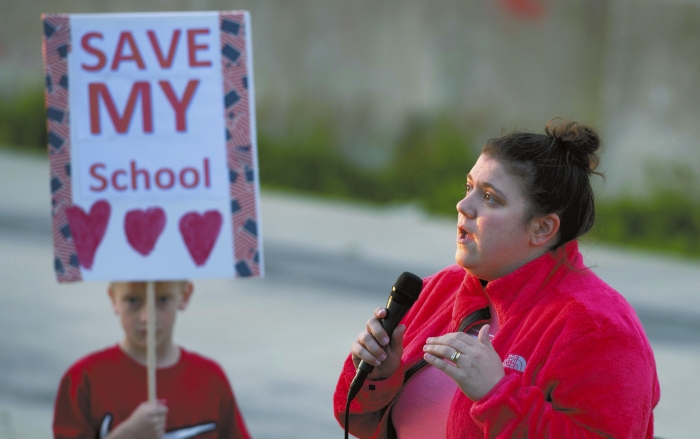Elizabeth Cook: People are passionate about schools
Published 12:00 am Sunday, April 17, 2016

- Beverly Smith, from Faith school, was one of the parents that spoke in 2016 when concerned parents gathered at the Rowan County Fairgrounds. Photo by Jon C. Lakey, Salisbury Post.
Now that the public has given the school board a taste of the fury school closings could bring, let’s all step back and take a breath.
This is the beginning of a process, not the end.
The Rowan-Salisbury Board of Education has been hinting at school closings for some time. No one paid much attention until they learned which schools might close.
In consultants’ Scenario 1, Mount Ulla would close, with its students largely folded into a new northwest school along with Woodleaf and Cleveland students.
Others to close would be Enochville, Morgan and Faith. Attendance zone lines would be adjusted across the county, domino-style, to absorb the students.
Eighteen hundred now-empty seats would be filled.
For the families of 2,000 children, the school consolidation discussion instantly went from hypothetical to personal — deeply, deeply personal.
Social media went red-hot with angry reaction. About 100 people attended a “save our schools” rally at the fairgrounds.
School board members sought to explain their stands more fully in letters and columns in the paper. The plan that looked reasonable when consultants presented it at the board’s retreat clearly lacked a crucial ingredient, public input.
I happened to attend that meeting. The board was going to hear a report on demographic trends in Rowan County, I thought, and I wanted to hear it too.
Instead, consultants presented the school closing plan. I was stunned. Remembering how passionately people fought years ago not to be redistricted away from some of these very schools, I knew the idea of closing them would meet fierce opposition.
While the mention of closing six schools gave me an “uh-oh” moment, school board members met the proposal with a fair amount of optimism.
The consultants referred to the proposal as “Scenario 1,” but they presented no others. They said this one emerged as a good place “to begin.”
Let’s begin at the real beginning — birth rates. Now that Baby Boomers’ children have matriculated through the schools, there’s no big cohort on the horizon. Births peaked in this area seven or eight years ago, so the group now in elementary school might be the largest we’ll see for a while.
This leveling-off is not just a Rowan County fact of life; the trend extends across the country — in rural areas, especially. Among North Carolina’s 80 rural counties, 48 lost population between 2010 and 2014. Young people are gravitating to the cities and having their children there.
The swell in enrollment for which Rowan County built new schools just a decade or two ago has subsided. Now we have excess capacity.
Why didn’t someone foresee that and hold off on building schools? Oh, for a crystal ball. School construction lags behind enrollment growth by at least five years. Some campuses had rows and rows of mobile classrooms before plans were drawn up for new schools. Teachers were holding classes in auditoriums and alcoves. Specialists were working with students in former closets.
Try telling parents not to worry about overcrowding in their children’s school because enrollment might fall 10 years from now.
The time for children to learn is always right now; they can’t wait years for better conditions.
And no one knew a double whammy was about to bear down on Rowan — thousands of lost manufacturing jobs, followed by a national Great Recession.
Educating children is a critical and expensive responsibility. As school board member Chuck Hughes said recently, “Fourteen full capacity schools are more economical to run than 20 under-utilized schools.”
Board member Travis Allen said he envisioned reducing the number of old buildings over 10 to 15 years, not overnight. “The problem we are faced with now is an old infrastructure and limited funding to combat many of our flooring, roofing, HVAC and other building needs,” Allen said.
Chairman Josh Wagner asked for input. “I would urge the community to provide feedback regarding not only consolidation, but other options as well,” he said.
Again, Rowan is not alone. Neighboring Stanly County recently decided to shut down Oakboro Elementary School. To the west, Central Elementary School in Waynesville is closing.
Some have protested that looking at schools purely on a financial basis overlooks the needs of children and is cold-hearted. The school system must balance its budget, though. Neither the General Assembly nor the Board of Commissioners is keen on spending more money on schools. The school board faces tough decisions.
Board members need the public’s help, beyond pleas of “don’t close my school.” The system has too many roofs to repair, too many buildings to keep up — and not enough money. How would you deal with this dilemma?
The people of Woodleaf and Cleveland are not happy about their schools closing, but water problems at Woodleaf made change inevitable.
Are more closings inevitable? If you have a better idea, please speak up.
Elizabeth Cook is editor of the Salisbury Post.

